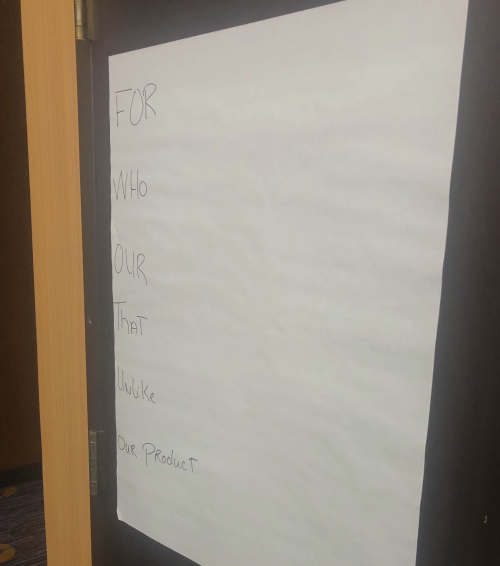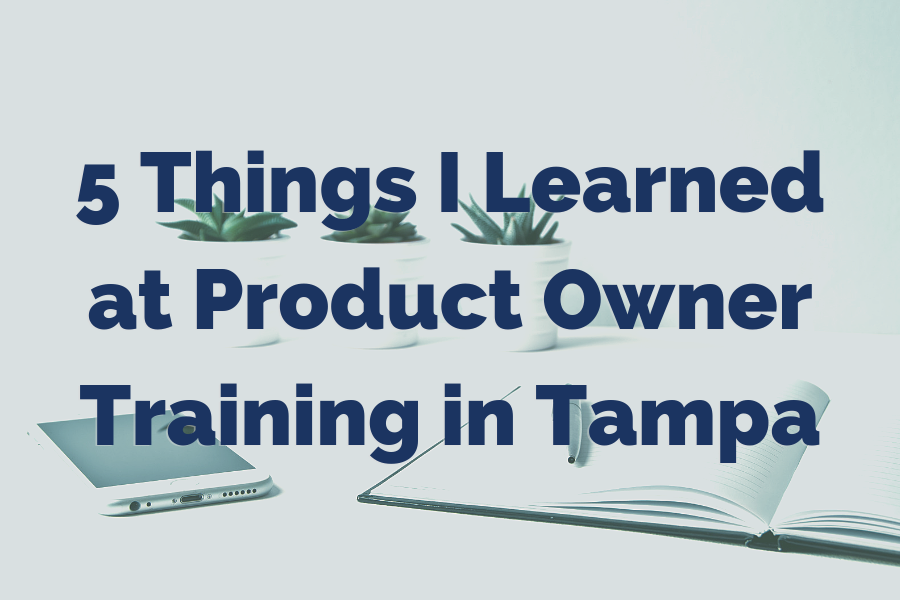As a new employee with Big Fish, I had the opportunity to attend Certified Scrum Product Owner (CSPO) training on June 5th and 6th in Tampa. It was led by the Braintrust Consulting Group.
The training was provided by Big Fish to enhance my abilities as a Project Coordinator, which truly exemplifies one of Big Fish’s core values to Learn and Grow. Through the training, I picked up helpful information and useful tools to be a successful Product Owner.
The CSPO course uses class participation to understand the Product Owner’s role and how to successfully implement Scrum in the workplace. Here are several of my top takeaways from this Product Owner training in Tampa.
1. Start with a Vision Statement
The vision sets the stage for what exactly the client would like to achieve.
In order to create a well-crafted and custom product, the development team and Product Owner need to understand what the overall dream or vision is.

-
- “For <Customer Name>
- Who <Statement of Need>
- Our <Product Name> is a
- <Product Category>
- That <Key Benefit or Reason to Buy>.
- Unlike <Primary Competitive Alternative>
- Our product <How it is Different>.”
The Vision Statement provides “what” is the product supposed to be about.
This is essential for the company to understand what they need, rather than “how” they need it, at the beginning planning phase.
Creating a vision statement is also helpful to the Product Owner, and entire product team, to understand the client’s needs and determine which items should be completed to fulfill the company’s vision.
2. Overhead Impacts the Product Owner’s Productivity
An optimal team is essential for productivity in creating and developing a product.
The team is optimal if it is made up of 3 to 9 members (most optimal at 4 or 5 members). To be proficient and successful, the Product Owner needs to be available, empowered, knowledgeable, and accountable.
The Product Owner should focus primarily on their one team as each team takes about 20% of overhead. This means that each additional team a Product Owner oversees, the likelihood that their reduction in oversight and productivity is about 20%.
Unlike many corporate companies, Big Fish uses a small team of crafted members to produce quality products. Through a small team, the Product Owner can accurately represent the business stakeholders, set the product vision, and navigate the product backlog.
3. Gaining Buy-in and Consensus with Stakeholders
When working with the stakeholders, you need to ensure that each participant has “buy in” to the product that is being built.
The stakeholders want to know what they can expect during the development process and how the project impacts them. It is crucial that the Product Owner provides transparency of the production process.
The stakeholders may agree that a product is needed but deciding what is necessary can be difficult.
Some ways that you can facilitate a consensus of what items are necessary are through techniques like the “Fist of Five” rating, or Dot Voting.
The voting techniques are explained below.
-
- Fist of Five – each stakeholder votes 1 through 5 with their fingers, 0 being the least desired and 5 if they absolutely love it. The Product Owner facilitates the voting process per item and identifies the stakeholder wants.
- Dot Voting – each stakeholder gets a select number of dot stickers. They place their dots on their desired item and the Product Owner reviews which items had the most votes.
Through these techniques, stakeholders can participate in what they want and help identify features they would like to have developed.
The technique allows the stakeholders to engage in their product and provides the Product Owner a layout of what specifically needs to be completed.
4. Using the MoSCoW Method to Determine Value
The MoSCow Method is a tool that can be used to determine the most valuable product to be developed.
The MoSCow Method is broken down into must have, could have, should have, and won’t have but want. Below is an example of how we could use this method to develop a car:
-
- M- Must have this – engine, tires, frame, seats, steering wheel
- S – Should have this – air conditioning, windows, mirrors
- C – Could have this – automatic transmission, mechanical seats, automatic windows
- W- Won’t have but would like – Moonroof, sunroof, navigation system
Using the MoSCow method allows the Product Owner to determine the most important items that need to be completed first, as they bring the most value to the business.
5. Sprint Review Showmanship
Lastly, the sprint review is a time where you review the product or feature developed during the latest sprint. The sprint review is a meeting that the stakeholders, team and Product Owner attend after each sprint to discuss what went well, what was achieved and to receive feedback.
During the review, the product is demonstrated to the stakeholders. Many times, the features being demonstrated are small, yet developed specifically for the client.
This is the time for the Product Owner to demonstrate and talk up all the hard work that the team has done during the last sprint period.
Instead of indicating that the team developed the login feature, indicate what that means to the company.
For instance, the Product Owner can discuss the login functionalities, what secured login will grant, and what happens if you forget your username or password. This provides the stakeholders with a better understanding of their customized features.
Wrapping it Up
Spending two days at this fun and informative Product Owner training will give you a deep immersion into the world of agile product management. Participants receive hands-on exercises, real-world examples and a review of key concepts and benefits of using Scrum firsthand.






